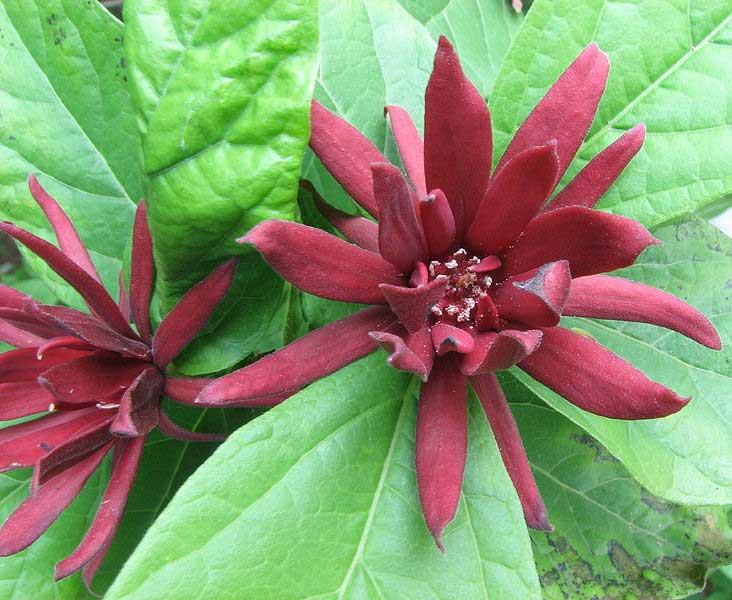
Calycanthus floridus (*)
Classification System: APG IV
Superregnum: Eukaryota
Regnum: Plantae
Cladus: Angiosperms
Cladus: Magnoliids
Ordo: Laurales
Familia: Calycanthaceae
Subfamilia: Calycanthoideae
Genus: Calycanthus
Species: Calycanthus floridus
Varietas: C. f. var. floridus – C. f. var. glaucus
Name
Calycanthus floridus L., Syst. Nat. ed. 10, 2: 1066 (1759).
Synonyms
Homotypic
Beurera florida (L.) Kuntze, Revis. Gen. Pl. 5. 1891.
Buttneria florida (L.) Kearney, Bull. Torrey Bot. Club 21: 175. 1894 (Buettneria).
Butneria floridus (L.) Britton
Hybrids
× Sinocalycalycanthus raulstonii F.T.Lass. & Fantz
Distribution
Native distribution areas:
Continental: Northern America
Regional: Southeastern USA
USA (Alabama, Delaware, Florida, Georgia, Massachusetts, Maryland, Mississippi, North Carolina, Pennsylvania, South Carolina, Tennessee, Virginia, West Virginia)
References: Brummitt, R.K. 2001. TDWG – World Geographical Scheme for Recording Plant Distributions, 2nd Edition
References
Linnaeus, C. 1759. Systema naturae per regna tria naturae, secundum classes, ordines, genera, species, cum characteribus, differentiis, synonymis, locis. Tomus II. Editio decima, reformata. Pp. [I–VI], 825–1384. Impensis direct. Laurentii Salvii, Holmiae [Stockholm]. BHL Reference page.
Links
Govaerts, R. et al. 2019. Calycanthus floridus in World Checklist of Selected Plant Families. The Board of Trustees of the Royal Botanic Gardens, Kew. Published online. Accessed: 2019 Jul. 18. Reference page.
Hassler, M. 2019. Calycanthus floridus. World Plants: Synonymic Checklists of the Vascular Plants of the World In: Roskovh, Y., Abucay, L., Orrell, T., Nicolson, D., Bailly, N., Kirk, P., Bourgoin, T., DeWalt, R.E., Decock, W., De Wever, A., Nieukerken, E. van, Zarucchi, J. & Penev, L., eds. 2019. Species 2000 & ITIS Catalogue of Life. Published online. Accessed: 2019 Jul. 18. Reference page.
International Plant Names Index. 2019. Calycanthus floridus. Published online. Accessed: Jul 18 2019.
The Plant List 2013. Calycanthus floridus in The Plant List Version 1.1. Published online. Accessed: 2019 Jul 18.
Tropicos.org 2019. Calycanthus floridus. Missouri Botanical Garden. Published online. Accessed: 18 Jul 2019.
Vernacular names
Ελληνικά, Κυπριακά: Καλύκανθος
suomi: Karolinankalukki, kalukkipensas
Calycanthus floridus, or commonly known as the eastern sweetshrub, Carolina all spice, or spice bush,[2] is a species of flowering shrub in the family Calycanthaceae.[3] It is identifiable by its dark red flowers and fragrant scent. It is non-invasive and is found in the Southeastern United States region. The Nature Conservancy considers its conservation status to be G5, indicating it is at low risk of extinction.[4]
Description
Calycanthus floridus is a shrub that grows to be around 6 to 9 ft (2 to 3 m) tall.[5] Its leaves are a dark green with a pale underside. They are ovate or elliptical in shape and grow to be about 6 inches in length.[5] The leaves are simple, entire, and arranged oppositely along the stem.[6]
The flowers are solitary, featuring a reddish brown to reddish purple color when they bloom in spring. They are aromatic and so are the leaves when bruised.[5] The flowers have a hypanthium that is more than 2 cm (0.8 in) long.[7] The shape of the flowers can be cylindrical, ellipsoid, pyriform, or globose.[8] The flowers have numerous tepals that can either be oblong-elliptic or obovate-lanceolate at maturity.[8] The flowers are perfect, having both stamens and carpels on the flowers. The stamens are numerous, connective beyond the anthers.[7] The carpels are numerous. They are free, with a single ovary in a locule.[7]
The fruits are indehiscent pseudocarps that are about 8 cm (3 in) in length and 5 cm (2 in) in diameter at maturity.[7] They are formed within the receptacle and contain numerous achenes that are roughly 10 mm (0.4 in) long with a 5 mm (0.2 in) diameter.
Leaves
Flower
Taxonomy
Oldest illustration, from a work by Mark Catesby published from 1731 onwards
Calycanthus floridus was first scientifically described by Carl Linnaeus in 1759.[1] It was the only species in his new genus Calycanthus. Linnaeus referred to an earlier illustration by Mark Catesby,[9] contained in a work published from 1731 onwards.
Distribution and habitat
Calycanthus floridus is native to the eastern United States.[10] It prefers sunny habitats but can tolerate moderate amounts of shade. It grows well in environments that feature moist substrate.[11]
Uses
It is used in horticulture as the flowers are showy and fragrant.[11] The bark of the plant is edible and is reportedly used as a substitute for cinnamon.[12] The petals of the flower are also reportedly used in tea-making.[12] Strong caution is advised however, as an alkaloid in the plant may lead to heart convulsions.[12] The viscous substance within the plant is reportedly used as a disinfectant.[12]
It is highly resistant to diseases and insects, although it is prone to infection by Agrobacterium tumefaciens, which leads to the formation of crown galls on the stems.[10][13]
This plant has been marked as a pollinator plant, supporting and attracting beetles.[14]
References
"Calycanthus floridus L." International Plant Names Index (IPNI). Royal Botanic Gardens, Kew. 11 February 2021. Retrieved 2021-02-11.
"Calycanthus floridus (Bubby Bush, Carolina Allspice, Common Sweetshrub, Spicebush, Sweet Betsy, Sweet Bubby Bush, Sweetshrub, Sweet Shrub) | North Carolina Extension Gardener Plant Toolbox". plants.ces.ncsu.edu. Retrieved 2020-04-03.
"Plants Profile for Calycanthus floridus (eastern sweetshrub)". plants.usda.gov. Retrieved 2020-04-03.
"Calycanthus floridus". explorer.natureserve.org. Retrieved 2020-04-19.
"Calycanthus floridus - Plant Finder". www.missouribotanicalgarden.org. Retrieved 2020-04-03.
"Carolina allspice". www.mortonarb.org. Retrieved 2020-04-19.
Radford, Albert E. (1968). Manual of the vascular flora of the Carolinas. Ahles, Harry E.,, Bell, C. Ritchie. Chapel Hill: University of North Carolina Press. ISBN 0-8078-1087-8. OCLC 355003.
"Calycanthus floridus". www.efloras.org. Retrieved 2020-04-03.
Linnaeus, C. (1759). "Calycanthus". Systema naturae per regna tria naturae, secundum classes, ordines, genera, species, cum characteribus, differentiis, synonymis, locis. Vol. II (10th ed.). Stockholm (Holmia): Salvius. p. 1066.
"Lady Bird Johnson Wildflower Center - The University of Texas at Austin". www.wildflower.org. Retrieved 2020-04-20.
"Calycanthus floridus | Landscape Plants | Oregon State University". landscapeplants.oregonstate.edu. Retrieved 2020-04-20.
"Calycanthus floridus, Carolina Allspice, Eastern sweetshrub, Strawberry Bush, Sweetshrub, Carolina Allspice PFAF Plant Database". pfaf.org. Retrieved 2020-04-20.
Gilman, Edward (27 May 2015). "Calycanthus floridus, Carolina Allspice, Sweetshrub". EDIS. Archived from the original on 2008-03-18. Retrieved 2020-04-16.
"Planting Guides" (PDF). Pollinator.org. Retrieved 2022-01-29.
Retrieved from "http://en.wikipedia.org/"
All text is available under the terms of the GNU Free Documentation License

